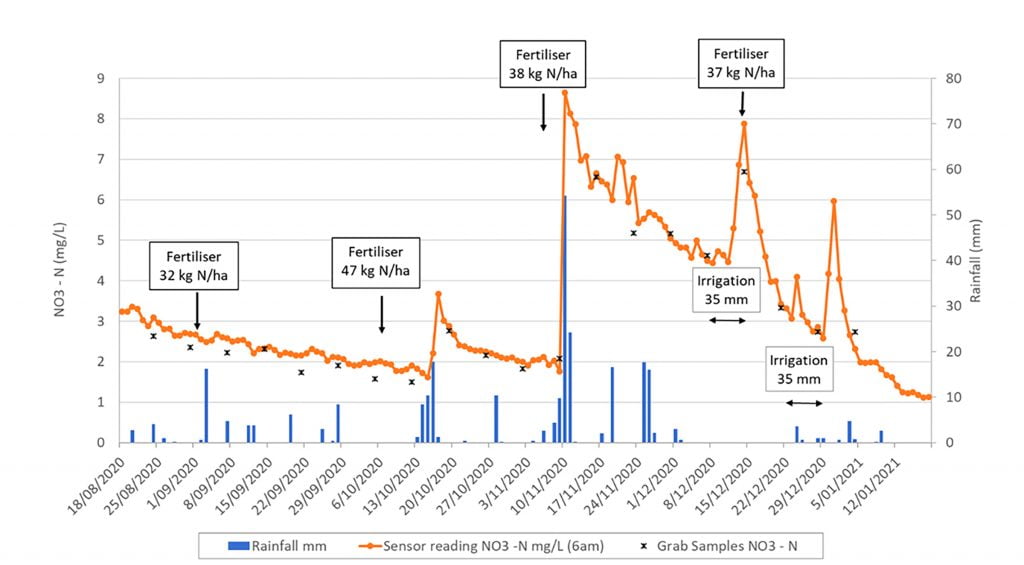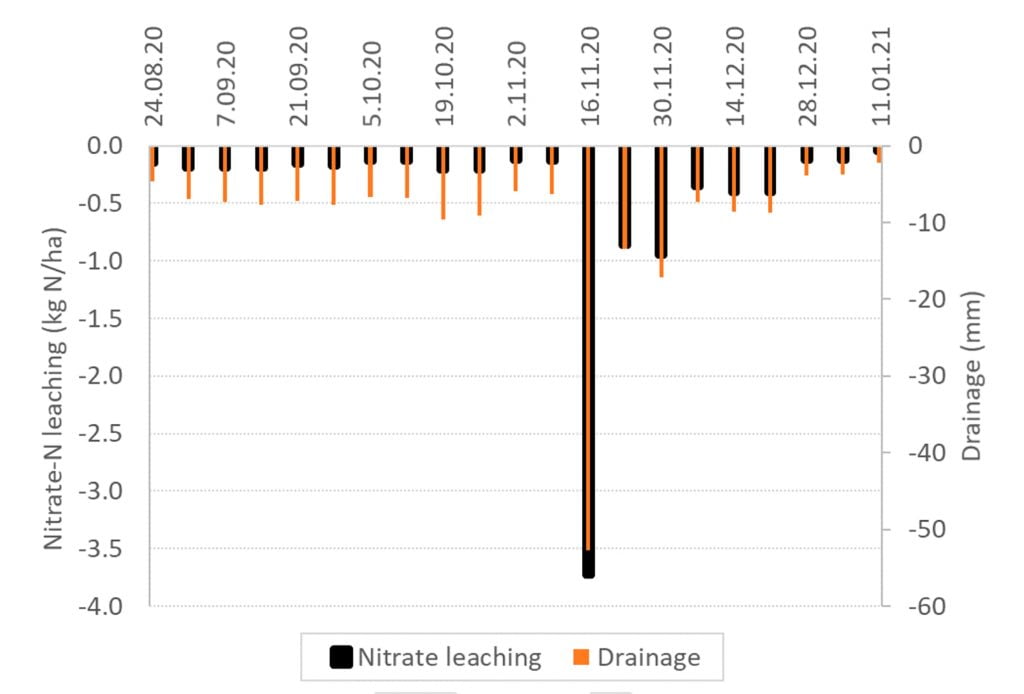Measuring Real-Time Nitrate Loss from Cropping Leachate
Farmers want to look under the bonnet to see how something works. With more pressure to measure and reduce nitrate loss in leachate from vegetable production, real-time measurement may help link better management to lower nitrate losses.
Intensive export and process vegetable growing is the name of the game on the Heretaunga Plains in the Hawke’s Bay. Around 5,800 ha of vegetables are planted annually, with a combination of conventional and organic horticulture soaking up both the sun and plentiful rain.
It is a busy and dynamic landscape. Gulls flock to soil behind tractors turning paddocks for new crops in spring. The back and forward of tractors applying fertiliser. irrigation guns shooting water streams on hot summer days.
But regulations are tightening up around crop cultivation under the Hawke’s Bay Regional Council’s proposed Plan Change 9 (TANK). Hundreds of horticultural growers would need to develop a management plan, including identifying and addressing risks to waterways from nutrient (nitrogen and phosphorus) loss. Nitrate is the main form of nitrogen being lost in these systems.
Measuring the amount of nitrate being lost through leaching and drainage in real time presents growers with a serious challenge. There is a big knowledge gap around nitrate losses from vegetable systems, especially in how crops respond to daily management decisions – let alone cropping cycles.
“We know there are nitrate losses, but there was no tangible way of knowing what those losses were,” says Ravensdown consultant Jamie Thompson.
Jamie developed a project, funded by the Our Land and Water Rural Professionals Fund, to help fill that gap. The project aimed to provide data to improve existing modelling, or develop new models that better reflect those changing conditions.
Organic conversion
Jamie connected with Bostock New Zealand grower Chris Zuierwijk. Bostock is the biggest organic apple grower in the southern hemisphere and is currently moving their cropping operations to organic production. This will see 1,500 ha of organic cropping added to 680 ha of organic apple orchards, with most of these crops exported.
Having been a grower with Bostock using both conventional and organic production methods for 12 years, and as a nurseryman growing seedlings for other growers before that, Chris has a broad understanding of cropping in the area.
A year ago, Bostock began looking at bringing a 16 ha cropping paddock near Clive into organic production. The conversion process would end the use of any conventional inputs and synthetic fertilisers. After the land had been lying fallow over winter, one last conventional crop of onions would be grown by Chris before he changed over to organic management.
Although not officially part of the original Our Land and Water project, which would cover the last onion crop, this changeover would give Jamie and Chris a fascinating opportunity to not only measure the levels of nitrate coming off a standard vegetable block, but also compare the difference organic management might have on losses on the same piece of land.
We know there are nitrate losses, but there was no tangible way of knowing what those losses were
The soil in the area is naturally poorly drained, with a dense clay-rich subsoil about 50 cm below the soil surface, and with a high water table in winter adding to the problem. This sees paddocks in the area growing high-value crops increasingly being artificially drained.
The Bostock-managed paddock has tile-and-mole drainage. All the drains in the paddock lead to a single sump.
Jamie installed a TriOS Nico nitrate sensor, one of the sensors used internationally to measure nitrate-nitrogen concentrations in wells and sumps. Comparing this data with that of regularly collected water samples analysed in a lab would show how accurate regular sampling was and whether events were being missed, as well as the effects of irrigation and wet weather events on nitrogen leaching.
In real time
Soil samples were collected when the crop was planted and when the crop had finished in January. Samples were sent to Analytical Research Laboratories (ARL) in Napier to measure mineral nitrogen.
After the onions were planted in early August, fertiliser was applied four times, about a month apart, from early September, with a total of 153 kg of nitrogen applied per hectare.
Soil moisture was gauged every couple of hours at 15, 30 and 60 cm depths at the front and back of the field by Decagon sensors, with weekly drainage recorded by two flow meters.
The TriOS Nico nitrate sensor Jamie had installed in the sump measured the nitrate in the water every hour, and every week a sample of the same water in the sump was collected, immediately taken to ARL and the nitrate concentration measured.
Chris took note of the eventual onion crop yield, with 20 onions also going to ARL to measure their nitrogen content.
Outcomes
There was 113 kg/ha of mineral nitrogen in the soil at planting with 86 kg/ha remaining in the soil, mostly near the surface, when the onions were lifted.
The sump sensor and weekly sampling showed nitrate leaching whenever it rained, with losses of about 0.16 kg/ ha each week. A big downpour in November, within a week of fertiliser going on, saw a huge spike with 3.7 kg/ha of nitrate lost in a week (see Figure 1).

With the soil now saturated, nitrate leaching stayed high, gradually decreasing through to the end of cropping, with a couple of more spikes from irrigation, and 9 kgN/ha was lost in total from the paddock (see Figure 2).

The TriOS Nico nitrate sensor and the grab samples showed similar results. Summing up losses, the sensor measured 8 percent more nitrate loss than lab results. This difference is not material and means that in this artificially drained field, weekly grab samples are not underestimating nitrate losses.
This was a positive result, says Jamie, showing a clear link between management practices, rain events and nitrate leaching. If no time was available to take grab samples, the sensor would give farmers confidence they could measure total losses, but also see real-time nitrate losses.
From this, farmers could decide if they wanted to reduce the depth of each irrigation, use less fertiliser each application, and increase the number of applications through the growing season. However, they would need to consider any potential increase in CO2e from running machinery.
With the onion crop off the ground, Chris’s organic conversion began with a cover crop of oats planted, along with using compost and chicken manure from Bostock’s organic chicken operation.
Jamie has continued with the sensor and grab samples, with indications the cover crop was soaking up surplus nitrogen and reducing nitrate losses.
Next steps
Extension funding has been granted through the Rural Professionals Fund to enable a full year of data capture through the catch crops and export squash crop cycle, and comparison of ‘actual vs modelled’ data.
– Delwyn Dickey for Our Land and Water National Science Challenge
More information:
- Rural Professionals Fund 2020-21
- Download PDF
- All text in this article is licensed for re-use under Creative Commons Attribution 4.0 International (CC BY 4.0)
Author
 View Our Strategy Document 2019 – 2024
View Our Strategy Document 2019 – 2024




Leave a Reply